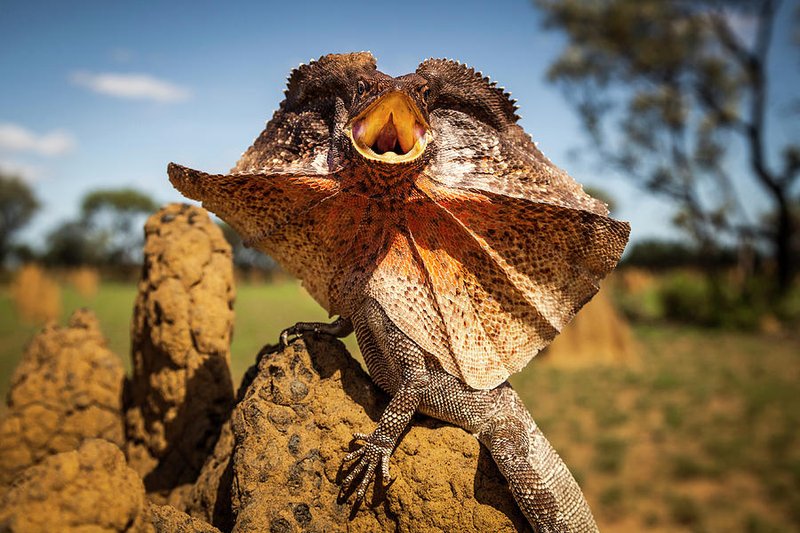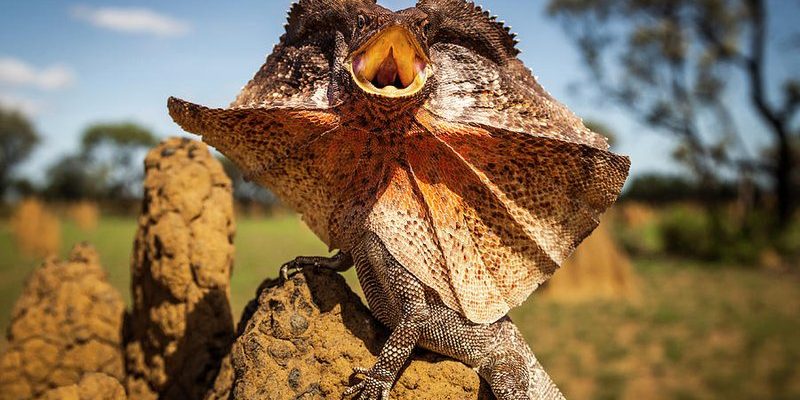
Let’s dive into the world of frilled lizards and explore their quirky adaptations and clever survival tactics. From their remarkable physical features to their behaviors that help them cope with extreme climates, there’s a lot to admire about these lizards. So grab a cup of coffee, and let’s chat about how frilled lizards thrive in the wild, even when the odds seem stacked against them!
Unique Physical Features
One of the most striking things about frilled lizards is their frill, which is a unique fold of skin around their neck. When threatened, they can expand this frill to appear larger and more intimidating. Think of it like a lion’s mane; it’s all about making a strong impression. This display often stops predators in their tracks, giving the lizard time to escape.
But that’s not the only cool feature. Frilled lizards have a long, slender body that’s perfect for climbing trees and darting quickly through underbrush. Their coloration—which can vary from browns to greens—allows them to blend into their surroundings, providing excellent camouflage against potential threats. This ability to merge with their environment while still being able to effectively use their vibrant frill when it counts is a fascinating balance of defense and adaptation.
Another important physical trait is their sharp claws and strong limbs. These not only help them climb but are great for digging and finding shelter when the weather turns sour. Imagine living in a place where it could be scorching hot one day and pouring rain the next. Having a body designed for flexibility helps them navigate these harsh conditions.
Behavioral Adaptations
Frilled lizards are fascinating not just for their looks but also for how they behave in the wild. When it comes to survival, their behavioral adaptations play a crucial role. For starters, these lizards are primarily arboreal, meaning they spend a lot of time in trees. This isn’t just a preference; it’s a smart survival strategy! Staying up high generally keeps them away from ground predators and provides a better vantage point for spotting food.
They’re also pretty skilled at managing their energy. During the hottest parts of the day, frilled lizards tend to stay inactive, hiding in the shade or staying still to prevent overheating. This behavior resembles a lot of desert animals that have learned to conserve energy and only venture out when conditions are just right.
Now, when it comes to mating season, they exhibit some interesting behaviors. Males are known for their elaborate displays, using their frills to attract females. It’s as if they’re putting on a show, and only the best performers get a chance to mate. This display isn’t just a show-off tactic; it also helps them avoid confrontations with other males while demonstrating their health and vitality.
Diet and Feeding Strategies
What do frilled lizards eat? That’s a great question! These lizards are primarily insectivores, which means their diet mainly consists of insects. Common snacks include crickets, grasshoppers, and other small critters. This might not sound like much, but in the wild, being an efficient hunter can make or break your survival.
Their feeding strategy is interesting, too. Frilled lizards are known to hunt by ambushing their prey. They’ll often wait patiently until an unsuspecting insect wanders close enough. When the moment is right, they strike quickly, demonstrating agility and precision. Honestly, it’s like watching a little dinosaur in action!
In addition to insects, they also consume a variety of fruits and leaves when insects are scarce. This ability to adapt their diet based on availability is crucial when living in a harsh environment where food might not always be abundant. This flexibility helps them navigate the ups and downs of their ecosystem, much like how we might tweak our diets based on what’s in season or available at the grocery store.
Habitat and Climate Adaptation
Frilled lizards are most commonly found in the tropical rainforests of Australia and New Guinea. These environments can be challenging, featuring high temperatures and heavy rainfall. So, how do they adapt to such conditions? Well, their habitat choice plays a big role. They prefer living in trees where they can find shelter and food while avoiding ground-level dangers.
When it comes to climate, frilled lizards are champions of endurance. They have a remarkable ability to regulate their body temperature. During the heat of the day, they’ll often seek shade and become less active to conserve hydration and energy. It’s like their little internal thermostat knows when to turn the dial down.
Moreover, during the rainy season, their lifestyle helps them navigate the sudden influx of moisture. Being arboreal means they can evade some of the flooding that affects lower ground creatures. While other animals may struggle to adapt, frilled lizards simply climb higher, showcasing their ability to thrive in an ever-changing and sometimes unpredictable environment.
Social Behavior and Communication
Communication among frilled lizards is subtle yet effective. They rely not just on their stunning frills but also on body language and sounds to convey messages to one another. When feeling threatened, a frilled lizard might puff out its frill and hiss loudly. It’s a clear signal: “Back off!” This is usually followed by a dramatic retreat, which can confuse predators and buy them time to escape.
Social interactions aren’t limited to threats; they also engage in courtship behaviors during mating season. Male lizards will perform elaborate displays, bobbing their heads, expanding their frills, and even making soft sounds to woo potential mates. This kind of non-verbal communication is crucial in ensuring their survival and reproductive success.
Interestingly, frilled lizards can also be territorial. Males will establish a home range and may engage in confrontations with other males, which typically involves similar dramatic displays of their frills and hissing. It’s all part of maintaining a balance in their habitat, ensuring that there’s enough space and resources for everyone.
Conservation and Future Challenges
Despite their adaptability, frilled lizards face challenges. Habitat destruction due to deforestation and climate change poses serious threats to their survival. As their natural homes are destroyed, these lizards may find it increasingly difficult to find food, shelter, and mates. Honestly, that’s a tough situation for any animal.
Conservation efforts are crucial for protecting these fascinating creatures. By preserving their habitats and promoting awareness about their ecological significance, we can help ensure that frilled lizards continue to thrive. Engaging local communities in these efforts is vital because they often have the best insights into the ecosystem and how to protect it effectively.
You might be wondering what you can do to help. Simple actions like supporting conservation organizations or spreading awareness about these unique reptiles can make a significant difference. Every little bit helps when it comes to protecting our planet’s natural wonders.
The frilled lizard is a remarkable example of nature’s ingenuity. From its striking frill to its clever behavioral adaptations, it shows us just how resilient life can be, even in the harshest environments. These lizards remind us that survival isn’t just about strength; it’s also about being smart and adaptable.
As we learn more about these animals and the challenges they face, we can appreciate the delicate balance of nature. Understanding the frilled lizard’s world encourages us to think deeper about our role in protecting these amazing creatures. So, the next time you come across a frilled lizard—or even just think about them—remember how they thrive against the odds. After all, there’s a lot to admire in their story of survival.

